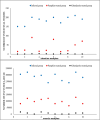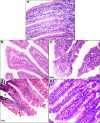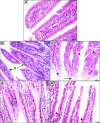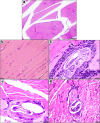Pumpkin seed oil: unveiling its potential in controlling inflammation and pathogenicity during experimental trichinellosis
- PMID: 39304848
- PMCID: PMC11414094
- DOI: 10.1186/s12917-024-04241-2
Pumpkin seed oil: unveiling its potential in controlling inflammation and pathogenicity during experimental trichinellosis
Abstract
Background: This study aimed to investigate the antiparasitic and anti-inflammatory potential of pumpkin seed oil in mice infected with Trichinella spiralis by demonstrating its impact on MMP-9 expression and pathogenesis during the intestinal and muscular phases.
Results: In this study, 100 mice were divided into five groups: an infected group, a pumpkin seed oil-treated group (1.5 mg/kg BW, administered three times per week), an albendazole-treated group, a native control group, and a pumpkin oil control group. Gas chromatography-mass spectrometry analysis of the pumpkin seed oil revealed a broad spectrum of biologically active compounds. The pumpkin seed oil treatment led to a significant reduction in the parasite burden, with a 75% decrease in adult worms and a 66% decrease in encysted larvae. Additionally, the infected animals treated with pumpkin oil exhibited a marked reduction in intestinal inflammation, characterized by a progressive increase in goblet cells. The number of encysted larvae in the diaphragm and muscle tissues was also significantly decreased. Furthermore, pumpkin seed oil treatment significantly reduced MMP-9 levels in both intestinal and muscular tissues, highlighting its potential to attenuate inflammation.
Conclusion: These findings underscore the effectiveness of pumpkin seed oil as anti-inflammatory and antiparasitic agent.
Keywords: Trichinella; Anti-inflammatory; Antiparasitic; MMP-9; Pumpkin seed oil.
© 2024. The Author(s).
Conflict of interest statement
The authors declare no competing interests.
Figures












Similar articles
-
A sustainable approach in pumpkin seed oil processing line: Recent advances in pumpkin seed oil and oil processing by-products.Food Chem X. 2025 Feb 4;26:102259. doi: 10.1016/j.fochx.2025.102259. eCollection 2025 Feb. Food Chem X. 2025. PMID: 39995405 Free PMC article. Review.
-
Nanocurcumin: A Promising Therapeutic Candidate for Experimental Trichinellosis.Microsc Microanal. 2024 Apr 29;30(2):368-381. doi: 10.1093/micmic/ozae007. Microsc Microanal. 2024. PMID: 38323506
-
Antioxidant and anti-inflammatory effects of ellagic acid as a new therapy for Trichinella spiralis infection.J Helminthol. 2024 Dec 10;98:e78. doi: 10.1017/S0022149X24000683. J Helminthol. 2024. PMID: 39654422
-
The antioxidant effects of pumpkin seed oil on subacute aflatoxin poisoning in mice.Environ Toxicol. 2013 Dec;28(12):681-8. doi: 10.1002/tox.20763. Epub 2011 Aug 31. Environ Toxicol. 2013. PMID: 24591108
-
The potential of pumpkin seed oil as a functional food-A comprehensive review of chemical composition, health benefits, and safety.Compr Rev Food Sci Food Saf. 2022 Sep;21(5):4422-4446. doi: 10.1111/1541-4337.13013. Epub 2022 Jul 29. Compr Rev Food Sci Food Saf. 2022. PMID: 35904246 Review.
Cited by
-
A sustainable approach in pumpkin seed oil processing line: Recent advances in pumpkin seed oil and oil processing by-products.Food Chem X. 2025 Feb 4;26:102259. doi: 10.1016/j.fochx.2025.102259. eCollection 2025 Feb. Food Chem X. 2025. PMID: 39995405 Free PMC article. Review.
-
Protective and therapeutic effects of Lactobacillus brevis PQ214320 and Bacillus subtilis PQ198038 Against experimental Trichinella Infection.PLoS Negl Trop Dis. 2025 Aug 11;19(8):e0013331. doi: 10.1371/journal.pntd.0013331. eCollection 2025 Aug. PLoS Negl Trop Dis. 2025. PMID: 40788963 Free PMC article.
-
Pumpkin Seeds as a Natural Remedy for Anemia: Nutritional Insights and Therapeutic Potential.Curr Ther Res Clin Exp. 2025 May 14;103:100797. doi: 10.1016/j.curtheres.2025.100797. eCollection 2025. Curr Ther Res Clin Exp. 2025. PMID: 40535566 Free PMC article. Review.
References
-
- Yadav AK. Temjenmongla: Efficacy of Lasia spinosa leaf extract in treating mice infected with Trichinella spiralis. Parasitol Res. 2012;110:493–8. - PubMed
-
- Nassef NE, Moharm IM, Atia AF, Brakat RM, Abou Hussien NM, Shamseldeen A. Therapeutic efficacy of chitosan nanoparticles loaded with albendazole on parenteral phase of experimental Trichinellosis. J Egypt Soc Parasitol. 2019;49(2):301–11.
-
- Speich B, Ali SM, Ame SM, Bogoch II, Alles R, Huwyler J, Albonico M, Hattendorf J, Utzinger J, Keiser J. Efficacy and safety of albendazole plus ivermectin, albendazole plus mebendazole, albendazole plus oxantel pamoate, and mebendazole alone against Trichuris trichiura and concomitant soil-transmitted helminth infections: a four-arm, randomised controlled trial. Lancet Infect Dis. 2015;15(3):277–84. - PubMed
MeSH terms
Substances
LinkOut - more resources
Full Text Sources
Miscellaneous

